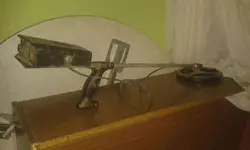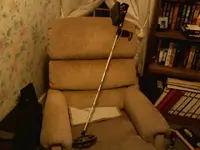G
Ground Squirrel
Guest
I have built the 'Matchless' Metal Locater from the Thunting.com site. Here in the link to the low-res PDF file...
http://www.thunting.com/cgi-bin/geo...age=metdet&file=/projects/matchless/index.dat
Changes in the internal design of the current stock of 556 timer IC's caused me to have to redesign the "pre-amp" stage and the timing resisters in the output osc. Overall it promised to be an interesting detector, but considering the requirement to build two loops and position them with very high precision, combined with the high amount of builder understanding of the components used in the project, I would rate this one as "poor". Defiantly not a beginner project, and most certainly not a project for someone who does not have analog -and- digital skills at the design level.
The results of the project produced a detector that was able to clearly distinguish the difference between ferrous and non-ferrous metals with pin-point accuracy to an air depth of around 4.5 inches. (I used a 1/4 inch piece of 1/4 inch copper bar and an equal piece of steel bar for testing) It was able to "find" a coin target (US quarter) oriented flat to the coil face at 6 inches. Distances measured with a plastic ruler, no estimates made while testing. Due to the huge amount of time spent re-designing the detector and the fiddly nature of the search coil orientation, I "retired" the project before producing a field-ready model.
The interesting thing about building this project was the very clear "yes" it's there, "no" it's not behavior of the detector. When there was no metal in range, the thing was stable and quiet. When an object entered the working range of the search coil, the detector was clear and unwavering about the material and position of the target.
Building this thing gave me a huge respect for my White's XLT. A LOT of time and skill went into the design and production of this, and all commercial detectors. While this comparison is not fare on any level, just considering the amount of time I spent working on the 'Matchless' Metal Locator... an XLT is a better deal.
GS
http://www.thunting.com/cgi-bin/geo...age=metdet&file=/projects/matchless/index.dat
Changes in the internal design of the current stock of 556 timer IC's caused me to have to redesign the "pre-amp" stage and the timing resisters in the output osc. Overall it promised to be an interesting detector, but considering the requirement to build two loops and position them with very high precision, combined with the high amount of builder understanding of the components used in the project, I would rate this one as "poor". Defiantly not a beginner project, and most certainly not a project for someone who does not have analog -and- digital skills at the design level.
The results of the project produced a detector that was able to clearly distinguish the difference between ferrous and non-ferrous metals with pin-point accuracy to an air depth of around 4.5 inches. (I used a 1/4 inch piece of 1/4 inch copper bar and an equal piece of steel bar for testing) It was able to "find" a coin target (US quarter) oriented flat to the coil face at 6 inches. Distances measured with a plastic ruler, no estimates made while testing. Due to the huge amount of time spent re-designing the detector and the fiddly nature of the search coil orientation, I "retired" the project before producing a field-ready model.
The interesting thing about building this project was the very clear "yes" it's there, "no" it's not behavior of the detector. When there was no metal in range, the thing was stable and quiet. When an object entered the working range of the search coil, the detector was clear and unwavering about the material and position of the target.
Building this thing gave me a huge respect for my White's XLT. A LOT of time and skill went into the design and production of this, and all commercial detectors. While this comparison is not fare on any level, just considering the amount of time I spent working on the 'Matchless' Metal Locator... an XLT is a better deal.
GS




 I loved playing with the detector when I was younger and believe that is why I bought my BH then my AT Pro this past year. I need to find a schematic for the detector (Archer Kit-Radio Shack) as there are a couple of wires that need soldered back on...but I need to know where. If anyone still has one I would love a picture of both sides of the PCB. Thanks
I loved playing with the detector when I was younger and believe that is why I bought my BH then my AT Pro this past year. I need to find a schematic for the detector (Archer Kit-Radio Shack) as there are a couple of wires that need soldered back on...but I need to know where. If anyone still has one I would love a picture of both sides of the PCB. Thanks
